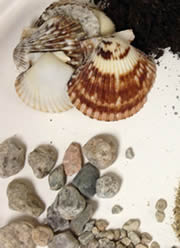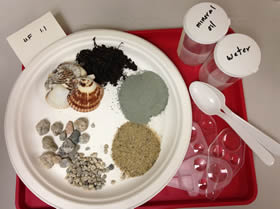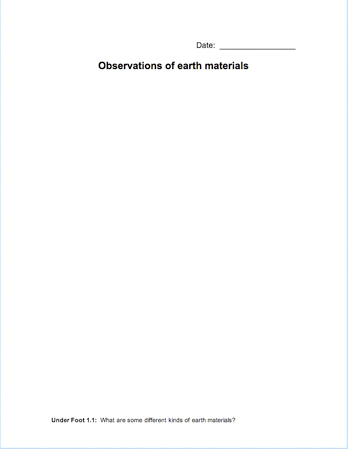What are some different kinds of earth materials?
Plan Investigation 1.1

What's underfoot? Carpet... wood... grass... sand... water? As we go about our daily lives, we seldom think about what's underfoot - unless we literally stumble across something new. In this study we "bring the outside in" to learn more about some of the natural materials that occur at or near Earth's surface. Students begin by imagining what they would find under their feet at various locations on Earth's surface and start to generate a list of materials they consider Earth materials. They then explore a small collection of common earth materials. Finally they gather to discuss the results, add to the list of Earth materials, and consolidate their ideas.
By the end of the investigation, students will have hands-on experience with common earth materials, including gravel, sand, clay, shells, organic soil, water, and oil. They will consider what might and might not be an earth material.
Learning Goals
- Become familiar with a variety of common earth materials
| Sequence of experiences | ||
|---|---|---|
| 1. Introduce the unit | All Class | 5 Mins |
| 2. Elicit ideas | Discussion | 15 Mins |
| 3. Explore earth materials | Small Groups | 15 Mins |
| 4. Make meaning | Discussion | 10 Mins |
Materials and Preparation

- Post the investigation question in a place where all students can see it.
- Student notebooks
- A large sheet of paper for recording a list of earth materials
- 1 plate of earth materials containing approximately 20cc each of gravel, sand, clay, organic soil, pebbles, and shells, arranged in piles
- 1 capped 150cc container with exactly 40cc of fresh water**
- 1 capped 150cc container with exactly 40cc of mineral oil**
- 4 magnifying glasses
- 4 plates
Note: The clay is not in the familiar moist, malleable form that students will recognize. All of the water has been removed, and just the tiny dry particles of clay remain. Its form is now more like a powder.
About mineral oil: Like corn oil and olive oil, the mineral oil that students will investigate today began as vegetal matter. But this oil was formed millions of years ago and it was trapped under ground for most of that time, causing it to change. The mineral oil has been refined; parts of the original oil have been separated and removed, so it is cleaner, but it still has most of its original properties. The products sold as "baby oil" are typically mineral oil.
* You may need to adjust the groups to suit your class size and configuration.
** These containers are used again in Investigation 2.1.





